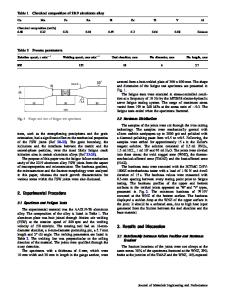Heat-Affected Zone Liquation Cracking Resistance of Friction Stir Processed Aluminum-Copper Alloy AA 2219
- PDF / 6,231,373 Bytes
- 16 Pages / 593.972 x 792 pts Page_size
- 61 Downloads / 354 Views
INTRODUCTION
LIQUATION cracking in the weld heat-affected zone (HAZ) is a common problem in fusion welding of many different aluminum alloys,[1] magnesium alloys,[2] and nickel-base superalloys.[3,4] It is essentially due to the formation of continuous grain boundary liquid films in the HAZ during the heating part of the weld thermal cycle. The liquid films often result from incipient melting of low-melting grain boundary constituents originally present in the base material. Cracking occurs during weld cooling when tensile stresses arising from the weld metal solidification act on the liquated grains in the HAZ. In general, fine-grained base materials show greater resistance to HAZ liquation cracking.[5,6] A fine grain size in the base material (hence more grain boundary area) lowers the concentration of liquation-inducing species at the grain boundaries and helps better accommodation of the stresses and strains in the HAZ. Recently, friction stir processing (FSP) has been proposed as a pretreatment to fusion welding for improved HAZ liquation cracking resistance. The basic idea is schematically illustrated in Figure 1. During FSP, the material is subjected to severe plastic deformation at high homologous temperatures (0.8 to 0.9 Tm).[7–9] As a result, the material in the stir zone dynamically recrystallizes and develops a very fine grain size. FSP can also help improve the HAZ liquation cracking resistance by removing any compositional inhomogeneities (segregation of alloying elements or
G.M. KARTHIK, G.D. JANAKI RAM, and RAVI SANKAR KOTTADA are with the Materials Joining Laboratory, Department of Metallurgical and Materials Engineering, Indian Institute of Technology Madras, Chennai, Tamil Nadu 600 036, India. Contact e-mail: [email protected] Manuscript submitted September 22, 2016. METALLURGICAL AND MATERIALS TRANSACTIONS B
impurities) or by causing fragmentation and redistribution of any low-melting second-phases originally present in the base material. The use of FSP as a pretreatment to fusion welding for improving HAZ liquation cracking resistance was first demonstrated by Mousavizade et al.[10] in cast nickel-base superalloy Inconel 738. In this work, the base plate was FSPed in a track and a bead-on-plate laser weld was made across the processed region. In microstructural examination, HAZ liquation cracks were found to occur in the unprocessed base material, but not in the FSPed region. The as-cast superalloy showed a very coarse dendritic structure consisting of a number of large semi-continuous carbides as well as low-melting c-c¢ eutectic nodules in the interdendritic regions; the grain/dendrite boundaries were also heavily segregated with melting point depressing elements such as boron. FSP was found to improve the liquation cracking resistance of the superalloy by recrystallizing the gamma matrix into very fine equiaxed grains, by breaking and redistributing the coarse carbides and other secondary solidification constituents, and by removing the original elemental segregation patterns. In another study, using si
Data Loading...











